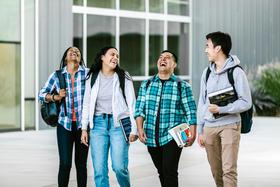A Nontraditional Student’s Guide to Community College (Updated 2025)
Community college can offer a flexible, affordable, and career-focused path for nontraditional students—those returning to education after time away, balancing work and family, or entering college later than the typical age. In 2025, new policies, financial aid programs, and support services are making community college more accessible than ever for nontraditional students. This guide updates key information, trends, and practical advice for navigating this route.
What Is a Nontraditional Student?
A nontraditional student is one who differs from the "typical" college student in one or more ways such as:
Being older than 24 at enrollment
Working full-time while attending school
Supporting dependents or raising children
Delaying college after high school or returning after interruption
Attending part-time rather than full-time
These students often juggle multiple responsibilities like jobs, families, financial obligations, and their own learning transitions.
Trends & Statistics in 2025
Recent data show nontraditional students are increasingly dominant in U.S. community colleges and higher education:
The American Association of Community Colleges (AACC)’s Fast Facts 2025 reports that community colleges now enroll 39% of all U.S. undergraduates, including large shares of Hispanic, Native American, and Black students. Community College Daily
Enrollment among students aged 30+ in community colleges has grown by ~4.3% recently, showing that older nontraditional learners are returning to college in greater numbers. league.org
Across many community colleges, ~43% of full-time students are employed full-time, underscoring the dual demands nontraditional students face. Watermark Insights
Cost, Free & Reduced-Tuition Options
One of the biggest concerns for nontraditional students is cost. In 2025, there are more programs aimed at reducing or eliminating tuition for nontraditional learners:
Massachusetts – MassReconnect & MassEducate: These programs cover tuition and fees (and in many cases, books or supplies) for Massachusetts residents 25 and older who don’t already hold a degree. MassReconnect helped nearly double enrollment in that nontraditional age group in 2023-24. Higher Ed Dive
SUNY Reconnect (New York State): Starting Fall 2025, individuals aged 25-55 who do not have a college degree can attend SUNY community colleges tuition-free (including fees, books, and supplies) when pursuing high-demand fields. SUNY
Many states and districts are expanding “Promise” and last-dollar programs, which cover remaining costs after federal/state aid. For example, Maryland offers a Promise Scholarship for 2025-26 that covers up to $5,000 to fill gaps in tuition and fees. Maryland Higher Education Commission
These initiatives change the calculus: nontraditional students no longer always have to pay full price.
Benefits of Community College for Nontraditional Students
Here are some up-to-date strengths of community colleges for nontraditional students:
Flexibility in scheduling and format
Evening, weekend, online, hybrid courses are more widely available in 2025. Some colleges offer asynchronous online modules so working students can complete coursework around job or family demands.Lower cost & reduced financial risk
In-district tuition for community colleges often runs between $3,000–$5,000/year for full-time students in many places. Coupled with aid and free-tuition programs, the out-of-pocket cost can be much lower. ThinkImpact.comTransfer pathways
Articulation agreements, dual enrollment (for those returning or catching up), and community college-to-university transfer agreements are more robust now. These help nontraditional students who may want to move on to a bachelor’s degree.Career & technical education (CTE)
Many nontraditional students are drawn to certificate programs, apprenticeships, or associate degrees tied to in-demand jobs. Health, technology, skilled trades are among the fastest-growing fields. Colleges are offering accelerated CTE tracks, support for adult learners, and wraparound services. Watermark Insights
Challenges & How They Are Being Addressed
Nontraditional students tend to face some unique challenges—but institutions are creating solutions in 2025:
| Challenge | Typical Impact | Emerging Supports |
|---|---|---|
| Time & scheduling conflicts | Work hours, family care limit course options; risk of dropping or extending time to complete. | More evening/online/hybrid courses; competency-based education; accelerated semesters. |
| Financial strain beyond tuition | Books, supplies, transportation, childcare can be major barriers. | Scholarship programs geared to adult learners (e.g., state “Reconnect” programs); grants covering supplies; emergency funds. |
| Academic reentry & confidence | Returning after gaps in schooling may require refreshing skills. | Bridge/preparation programs; tutoring; adult learner learning centers. |
| Navigating bureaucracy & aid systems | FAFSA, state aid, eligibility criteria can be opaque or burdensome. | Simplified application processes; more advising; state policy reforms (see Free community college programs). |
What to Look for When Choosing a Program
If you’re a nontraditional student thinking about community college, these are key factors to evaluate:
Tuition, fees, and available aid — including whether there are free or reduced-tuition programs for older students, or last-dollar scholarship opportunities.
Flexibility of delivery — does the college offer online, hybrid, evening, weekend courses? Is there part-time enrollment?
Support services — childcare, counseling, academic help, tutoring, career advising that understands nontraditional student needs.
Transferability — if your goal is to go from community college to a four-year institution, check whether credits transfer smoothly.
Workforce alignment — look for programs in high-demand fields and support for certifications/apprenticeships.
Real-World Examples
MassReconnect & MassEducate, Massachusetts: Nontraditional learners 25+ benefit from these programs; nearly doubled enrollment from this cohort in one year. Book and supply stipends are included for many students.
SUNY Reconnect, New York State: Free tuition, fees, books, and supplies for adult learners entering high-need fields. This program is designed to reduce barriers for people who delayed or paused college.
Promise Programs like Maryland Community College Promise Scholarship: Up to $5,000 to fill gaps after federal/state aid; open to part-time and full-time, vocational certificate or associate degree students.
Actionable Steps for Success
Here are practical tips nontraditional students can use in 2025 to make the most of community college:
Fill out FAFSA or state aid applications early — even if you think you might not qualify, some free/last-dollar programs require it.
Contact the college’s adult learner or nontraditional student office — many colleges have staff dedicated to helping students with reentry, overcoming gaps, planning their program.
Explore all financial aid options — check scholarships specifically for adult learners, veterans, single parents; research state programs like Reconnect, Promise, etc.
Plan your schedule — build in times for work, family, study. Choose classes and delivery modes that align with your responsibilities.
Build community & support networks — nontraditional students often benefit from peer groups, mentor programs, online forums, and support services which understand the specific challenges you face.
Clarify goals early — whether it's workforce credentials, transferring to a bachelor’s, or personal growth—having clear goals helps choose the right programs and stay motivated.
Frequently Asked Questions
Q: Is community college still worthwhile for someone who delayed education by 5-10 years?
A: Yes. With free/low-tuition programs, strong career-technical education, and flexible scheduling, returning later often means clearer purpose, and many community colleges have the experience supporting adult learners.
Q: Can credits from a community college count toward a bachelor’s degree?
A: In most states there are articulation agreements; always check with both your community college and potential four-year transfer institutions to ensure credits transfer.
Q: How do I balance working/full-time responsibilities with classes?
A: Look for hybrid/online options, part-time enrollment, accelerated semesters, and colleges with strong student support services.
Bottom Line
Community college in 2025 offers growing opportunities for nontraditional students. With free/last-dollar programs, state-level initiatives like Reconnect, Promise, and MassEducate, better scheduling flexibility, and improved support, the nontraditional student path is more viable than ever.
If you’re considering this path, research carefully, use available aid, leverage support services, and align your program with your goals. Community college can not only be affordable—it can be transformative.














